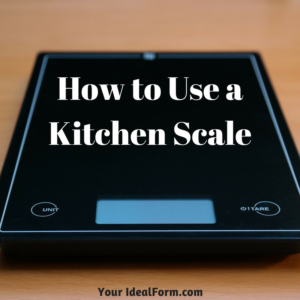
I’ve talked about different technologies I’ve used to help me reach my goal weight. But the number one device that was the most instrumental to my success is definitely my kitchen scale. More than any app, workout, or even my FitBit, my kitchen scale is truly the star of the show. Weighing out what I eat let me be as precise as possible when logging my intake. Here are some tips for getting the most out of this appliance.
Get one.
The first step is to actually get a kitchen scale. They are pretty inexpensive, and a decent digital scale can go for around $15. You can pick one up at stores like Target or Bed Bath and Beyond, or check Amazon for a wider selection.
Leave it out.
The next step is to actually use your kitchen scale. Leave it out on the counter so you remember to use it. You are also more likely to use your scale if it is right there rather than having to dig it out of a cabinet.
Tare it.
The tare (rhymes with hair) button on your scale will zero the scale out. This is an awesome feature that is not to be overlooked! It means that you don’t have to do math when logging your food. Turn on the scale. Place your empty plate on the scale. Now hit that tare button. The scale goes to zero. Load up your plate with your first ingredient, say some veggies. Log your veggies. Now hit the tare button again so the scale again goes to zero. Add the next food. Perhaps some rice. Log the amount of rice. Hit tare again. Add more food to the plate. Log it. Hit tare…. This way you don’t have to do math, and you also don’t need to dirty any extra dishes or containers while measuring out your food.
Use it.
It’s important to use your scale regularly. After awhile, you’ll get much better at estimating your portion sizes, but even so, continue to measure. It’s far too easy to start just guessing at a serving size, and soon, those servings start creeping up in size. Even after hitting my goal, I still use my scale to make sure that my intake isn’t creeping up. You don’t want to undo all that hard work!
Don’t guess.
A scale lets you be as accurate as possible when tracking your nutrition. A serving of grapes might be 10 grapes, but is that 10 small grapes? Green grapes? What about those big globe grapes? It’s more precise to just weigh it out and log 100 grams of grapes. It’s also useful when things like chips will list a serving size as so many grams or ounces and then say that it’s “about” 14 chips. Instead of counting it out, you can just measure the more accurate serving size.
I lied.
Ok, so using the tare button does prevent you from having to do math. IF your tracking allows you to log things in ounces or grams. But what happens when your only option for measurement is in cups or spoons? I see this a lot when I bake. One cup of sugar. Well, how many grams is that? Baking is chemistry, and getting the amounts juuuuuuuust right yields the best results, both taste and texture-wise. So I use my kitchen scale when measuring out my ingredients for the most accuracy. And my brownies and cookies are phenomenal. But this baking prowess does require some conversion wizardry. To make it easier on you, I’ve created a list of common ingredients and their measurement-to-weight equivalents so you can easily reference it whenever you need. Just fill out the form below to download your free conversion chart and get your kitchen scale working for you!
